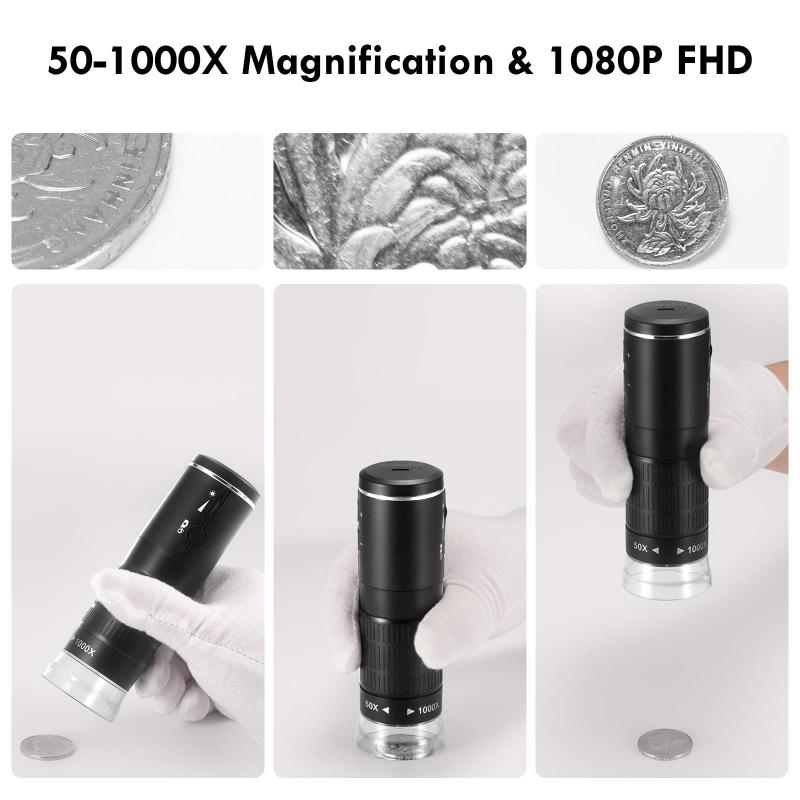What Is An Advantage Of An Electron Microscope ?
One advantage of an electron microscope is its high resolution. Due to the shorter wavelength of electrons compared to visible light, electron microscopes can achieve much higher magnification and produce detailed images with a higher level of clarity and resolution. This allows for the visualization of extremely small structures and the observation of fine details that may not be visible with other types of microscopes.
1、 Higher resolution for detailed imaging of small structures.
An advantage of an electron microscope is its ability to provide higher resolution for detailed imaging of small structures. Unlike light microscopes, which use visible light to illuminate specimens, electron microscopes use a beam of electrons to create an image. This allows for much higher magnification and resolution, making it possible to observe structures at the nanoscale level.
The higher resolution of electron microscopes is particularly advantageous when studying biological samples, such as cells and tissues. It enables researchers to visualize intricate details of cellular structures, such as organelles, membranes, and even individual molecules. This level of detail is crucial for understanding the inner workings of cells and unraveling complex biological processes.
Moreover, electron microscopes have been instrumental in various scientific fields, including materials science, nanotechnology, and pharmacology. In materials science, electron microscopy allows for the examination of the atomic structure of materials, leading to advancements in the development of new materials with specific properties. In nanotechnology, electron microscopes are essential for characterizing and manipulating nanoscale structures, which are the building blocks of many advanced technologies. In pharmacology, electron microscopy helps researchers study the interactions between drugs and their targets at the molecular level, aiding in the development of more effective and targeted therapies.
Furthermore, recent advancements in electron microscopy techniques have further enhanced its capabilities. For instance, the development of cryo-electron microscopy (cryo-EM) has revolutionized the field of structural biology. Cryo-EM allows for the imaging of biological samples in their native, frozen state, preserving their natural structure and enabling the visualization of previously inaccessible molecular details. This technique has been instrumental in determining the structures of complex biomolecules, such as proteins and viruses, leading to breakthroughs in drug discovery and vaccine development.
In conclusion, the advantage of higher resolution for detailed imaging of small structures is a significant benefit of electron microscopes. This capability has broad applications in various scientific disciplines and has been further enhanced by recent advancements in electron microscopy techniques. As our understanding of the nanoscale world continues to expand, electron microscopes will remain indispensable tools for scientific research and technological advancements.

2、 Ability to visualize objects at nanoscale.
An advantage of an electron microscope is its ability to visualize objects at the nanoscale. Unlike traditional light microscopes, which are limited by the wavelength of visible light, electron microscopes use a beam of electrons to create images with much higher resolution. This allows scientists to observe and study objects at a level of detail that would otherwise be impossible.
The nanoscale is the realm of atoms and molecules, where many important processes and interactions occur. Being able to visualize and understand these processes is crucial in fields such as materials science, nanotechnology, and biology. For example, electron microscopes have been instrumental in studying the structure and behavior of nanoparticles, which have unique properties due to their small size. By visualizing these nanoparticles, scientists can gain insights into their behavior and potential applications.
Furthermore, electron microscopes have evolved over time, with advancements in technology enabling even higher resolution imaging. For instance, the development of scanning transmission electron microscopy (STEM) allows for the simultaneous imaging and analysis of samples at atomic resolution. This technique has revolutionized the study of materials, enabling scientists to directly observe the arrangement of atoms and study their properties.
In recent years, electron microscopy has also been combined with other techniques, such as spectroscopy and tomography, to provide even more comprehensive information about samples. This multidimensional approach allows scientists to not only visualize objects at the nanoscale but also analyze their chemical composition and three-dimensional structure.
In conclusion, the ability to visualize objects at the nanoscale is a significant advantage of electron microscopes. This capability has opened up new avenues of research and has contributed to advancements in various scientific fields. As technology continues to improve, electron microscopes will likely play an increasingly important role in our understanding of the nanoworld and its applications.

3、 Enhanced depth of field for 3D imaging.
An advantage of an electron microscope is the enhanced depth of field it offers for 3D imaging. Unlike traditional light microscopes, electron microscopes use a beam of electrons instead of light to magnify and visualize samples. This allows for much higher resolution and greater depth of field, resulting in clearer and more detailed images.
The enhanced depth of field provided by electron microscopes is particularly beneficial for studying complex structures and materials in three dimensions. It allows researchers to observe and analyze the fine details of objects at various depths within the sample, providing a more comprehensive understanding of their structure and composition. This is especially important in fields such as materials science, nanotechnology, and biology, where the ability to visualize and analyze intricate structures is crucial.
Furthermore, the enhanced depth of field of electron microscopes enables the imaging of samples with uneven surfaces or varying thicknesses. Traditional microscopes often struggle to capture clear images of such samples due to their limited depth of field. In contrast, electron microscopes can produce sharp and detailed images even when the sample has irregularities or variations in thickness. This capability is particularly valuable in fields like geology, where samples often have complex surface features or geological layers that need to be examined in detail.
In recent years, advancements in electron microscopy technology have further improved the depth of field capabilities. For example, the development of scanning electron microscopes (SEM) with advanced detectors and software algorithms has allowed for even greater depth of field and improved 3D imaging. These advancements have opened up new possibilities for studying and understanding the intricate structures of various materials and biological specimens.
In conclusion, the enhanced depth of field provided by electron microscopes is a significant advantage for 3D imaging. It allows for clearer and more detailed visualization of complex structures and materials, enabling researchers to gain a deeper understanding of their properties and behavior. With ongoing advancements in electron microscopy technology, the potential for enhanced depth of field and improved 3D imaging continues to expand, offering exciting opportunities for scientific research and discovery.

4、 Capable of imaging non-conductive samples.
An advantage of an electron microscope is its capability to image non-conductive samples. Unlike optical microscopes, which use light to create an image, electron microscopes use a beam of electrons. This allows for higher resolution and magnification, making it possible to observe smaller details and structures in samples.
One of the main limitations of optical microscopes is that they cannot effectively image non-conductive samples. This is because non-conductive materials do not allow the passage of electrons, which are necessary for creating an image in an electron microscope. However, electron microscopes can overcome this limitation by using a technique called "scanning electron microscopy" (SEM).
In SEM, a beam of electrons is scanned across the surface of the sample, and the interaction between the electrons and the sample produces signals that can be used to create an image. This technique allows for the imaging of non-conductive samples, such as ceramics, polymers, and biological materials, which are often of great interest in various scientific fields.
Moreover, recent advancements in electron microscopy have further enhanced its capability to image non-conductive samples. For example, the development of environmental scanning electron microscopy (ESEM) allows for the imaging of samples in their natural, hydrated state. This is particularly useful for studying biological samples, as it enables researchers to observe dynamic processes and interactions that would otherwise be altered or destroyed by traditional sample preparation methods.
In conclusion, the advantage of an electron microscope in being capable of imaging non-conductive samples is a significant breakthrough in scientific research. It allows for the observation of a wide range of materials and opens up new possibilities for studying complex biological systems and other non-conductive samples. The continuous advancements in electron microscopy techniques further enhance its potential and contribute to the progress of various scientific disciplines.






























There are no comments for this blog.